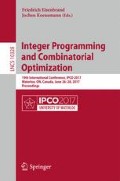Abstract
In this paper we consider one of the most basic scheduling problems where jobs have their respective arrival times and deadlines. The goal is to schedule as many jobs as possible non-preemptively by their respective deadlines on m identical parallel machines. For the last decade, the best approximation ratio known for the single machine case (\(m = 1\)) has been \(1-1/e - \epsilon \approx 0.632\) due to [Chuzhoy-Ostrovsky-Rabani, FOCS 2001 and MOR 2006]. We break this barrier and give an improved 0.644-approximation. For the multiple machine case, we give an algorithm whose approximation guarantee becomes arbitrarily close to 1 as the number of machines increases. This improves upon the previous best \(1 - 1/(1 + 1/m)^m\) approximation due to [Bar-Noy et al., STOC 1999 and SICOMP 2009], which converges to \(1-1/e\) as m goes to infinity. Our result for the multiple-machine case extends to the weighted throughput objective where jobs have different weights, and the goal is to schedule jobs with the maximum total weight. Our results show that the \(1 - 1/e\) approximation factor widely observed in various coverage problems is not tight for the non-preemptive maximum throughput scheduling problem.
S. Im—Supported in part by NSF grants CCF-1409130 and CCF-1617653.
S. Li—Supported in part by NSF grant CCF-1566356.
B. Moseley—Supported in part by a Google Research Award, a Yahoo Research Award and NSF Grant CCF-1617724.
Access this chapter
Tax calculation will be finalised at checkout
Purchases are for personal use only
Notes
- 1.
Suppose there are m machines. Then, in our new instance, the time horizon is (0, mT], which can be viewed as the concatenation of m horizons of length T. If a job can be scheduled in \((A, B] \subseteq (0, T]\) in the original instance, it can be scheduled in \((iT + A, iT + B]\) for every \(i = 0, 1, \cdots , m - 1\) in the new instance.
- 2.
- 3.
It is worth noting that this is where we crucially use the assumption that jobs have uniform weights.
- 4.
This is another place where we rely on the assumption that jobs have uniform weights.
References
Adler, M., Rosenberg, A.L., Sitaraman, R.K., Unger, W.: Scheduling time-constrained communication in linear networks. Theor. Comput. Syst. 35(6), 599–623 (2002)
Bansal, N., Chan, H.L., Khandekar, R., Pruhs, K., Stein, C., Schieber, B.: Non-preemptive min-sum scheduling with resource augmentation. In: FOCS, pp. 614–624 (2007)
Baptiste, P.: An O(\(n^4\)) algorithm for preemptive scheduling of a single machine to minimize the number of late jobs. Oper. Res. Lett. 24(4), 175–180 (1999)
Bar-Noy, A., Guha, S., Naor, J., Schieber, B.: Approximating the throughput of multiple machines in real-time scheduling. SIAM J. Comput. 31(2), 331–352 (2001)
Berman, P., DasGupta, B.: Improvements in throughout maximization for real-time scheduling. In: Proceedings of the Thirty-Second Annual ACM Symposium on Theory of Computing, pp. 680–687. ACM (2000)
Błażewicz, J., Ecker, K.H., Pesch, E., Schmidt, G., Weglarz, J.: Scheduling Computer and Manufacturing Processes. Springer Science & Business Media, Heidelberg (2013)
Chuzhoy, J., Ostrovsky, R., Rabani, Y.: Approximation algorithms for the job interval selection problem and related scheduling problems. Math. Oper. Res. 31(4), 730–738 (2006)
Fischetti, M., Martello, S., Toth, P.: The fixed job schedule problem with spread-time constraints. Oper. Res. 35(6), 849–858 (1987)
Garey, M.R., Johnson, D.S.: Two-processor scheduling with start-times and deadlines. SIAM J. Comput. 6(3), 416–426 (1977)
Hall, N.G., Magazine, M.J.: Maximizing the value of a space mission. Eur. J. Oper. Res. 78(2), 224–241 (1994)
Hong, K.S., Leung, J.Y.T.: Preemptive scheduling with release times and deadlines. Real Time Syst. 1(3), 265–281 (1989)
Koren, G., Shasha, D.: D\(^{\rm over}\): an optimal on-line scheduling algorithm for overloaded uniprocessor real-time systems. SIAM J. Comput. 24(2), 318–339 (1995)
Lawler, E.L., Lenstra, J.K., Rinnooy Kan, A., Shmoys, D.: Sequencing and scheduling: algorithms and complexity. Hanbooks Oper. Res. Manage. Sci. 4, 445–522 (1993)
Lipton, R.J., Tomkins, A.: Online interval scheduling. In: SODA, pp. 302–311 (1994)
McDiarmid, C.: Concentration. In: Habib, M., McDiarmid, C., Ramirez-Alfonsin, J., Reed, B. (eds.) Probabilistic Methods for Algorithmic Discrete Mathematics. Algorithms and Combinatorics, vol. 16, pp. 195–248. Springer, Heidelberg (1998)
Spieksma, F.C.: On the approximability of an interval scheduling problem. J. Sched. 2(5), 215–227 (1999)
Author information
Authors and Affiliations
Corresponding author
Editor information
Editors and Affiliations
Rights and permissions
Copyright information
© 2017 Springer International Publishing AG
About this paper
Cite this paper
Im, S., Li, S., Moseley, B. (2017). Breaking \(1 - 1/e\) Barrier for Non-preemptive Throughput Maximization. In: Eisenbrand, F., Koenemann, J. (eds) Integer Programming and Combinatorial Optimization. IPCO 2017. Lecture Notes in Computer Science(), vol 10328. Springer, Cham. https://doi.org/10.1007/978-3-319-59250-3_24
Download citation
DOI: https://doi.org/10.1007/978-3-319-59250-3_24
Published:
Publisher Name: Springer, Cham
Print ISBN: 978-3-319-59249-7
Online ISBN: 978-3-319-59250-3
eBook Packages: Computer ScienceComputer Science (R0)

